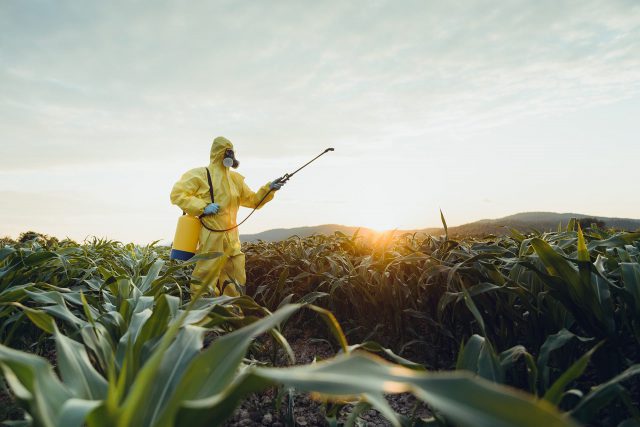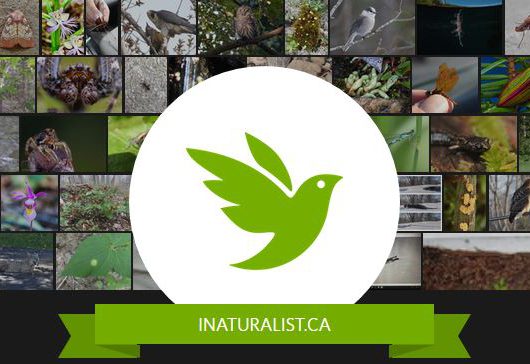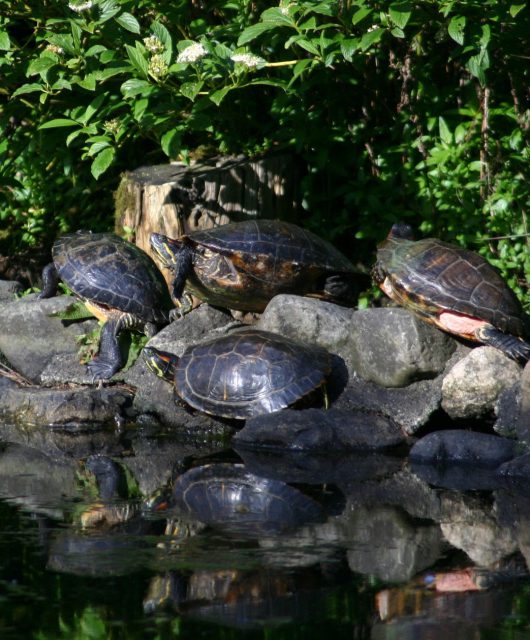As soils warm across the country, Canadian food producers are preparing to plant their crops.
But in a spring that seems like any other, one thing about this season should have been different.
In 2018, three neonicotinoid pesticides that have been banned in European nations (imidicloprid, clothianidin, and thiamethoxam) were set to be phased out as proposed by Health Canada’s Pest Management Regulatory Agency (PMRA). In Canada, the PMRA has the important responsibility to ensure that pesticides pose no more than minimal risk to human health and the environment. Their mandate is to carry out “stringent, science-based evaluations” to ensure that any risks are acceptable.
Neonicotinoids are the most commonly used class of insecticide in the world. They’re known for having a high degree of toxicity, and for being persistent in the environment. Neonicotinoid residues accumulate within the whole plant – even the nectar and pollen – regardless of their method of application. These chemicals can persist in the soil for a long time. In its 2001 review of imidacloprid, the PMRA stated that imidacloprid was persistent, with a half-life in soil of 1-2 years (the amount of time it takes half of the chemical to break down). Clothianidin is considered to be a bit over twice as long lived as imidacloprid; the same holds for thiamethoxam given that it first breaks down to clothianidin. These neonics are also very water soluble and likely to contaminate both ground and surface water. Neonicotinoids are used primarily to kill pest insects on crops, but they can also be fatally toxic to pollinators, birds, and aquatic organisms and impact other insect-eating wildlife such as bats.
The PMRA initiated re-evaluations of imidicloprid, clothianidin, and thiamethoxam ten years ago. By 2016 (for imidicloprid) and 2018 (for clothianidin, and thiamethoxam), the PMRA had reviewed hundreds of published scientific articles, including some that were based on Canadian studies. The environmental assessment concluded, rightly, that these neonicotinoids posed significant environmental risks, particularly in aquatic environments. The risks were deemed unacceptable. In 2018, the PMRA recommended that ALL agricultural, ornamental and greenhouse uses be cancelled and phased out over a three to five year period.
That decision, which was appropriate and correct given the global weight of evidence from more than 1,300 peer-reviewed scientific papers that exist on the environmental impact of these chemicals, should have been final.

This is why, in spring 2021, we were shocked when Health Canada did a complete about-face. Suddenly, these pesticides that were so hazardous to aquatic life that their use needed to be terminated, were deemed “largely acceptable with some mitigation.” The PMRA had reviewed some new monitoring data on neonicotinoid levels in prairie wetlands that showed neonicotinoids didn’t exceed safe levels after all. Was therenew peer-reviewed science that could explain the different findings? Not exactly.
The agricultural chemical industry provided the PMRA with additional data on contamination levels in the prairies, and these data were used by the federal government to base their reversal decision. While that is not in and of itself a bad thing, these data are now considered to be proprietary by the government. Any independent scientist wishing to scrutinize these data, such as where they were collected, whether they were collected in fields sprayed with these pesticides, how often they were sampled, is not permitted to do so in any rigorous manner. By PMRA basing their new toxicity levels on a few pond studies, they restricted the number of organisms considered and based their new assessment on studies with a weak power to show effects. This also meant rejecting the bulk of the science generated by independent researchers that led to the phase-out recommendation. European regulators have recognized this bias in pond studies and apply safety factors to the results.

The limitations imposed by the government of Canada on access to toxicological data is arcane. Anyone who wants to review the sources used by PMRA in a regulatory decision can do so – in Ottawa – in a “reading room” – with no computer. Then you have 30 days to search through stacks of physical papers, often totaling thousands of pages, recording what interests you with nothing more than a pencil and paper. Obviously, that would be difficult for anyone out-of-province and during a pandemic, so the PMRA has developed an alternative to the reading room: an encrypted, non-searchable pdf form that makes proper searching and scrutiny of data impossible.
PMRA considers toxicological studies and apparently also water sampling studies to be proprietary to the chemical companies registering the pesticides. We do not agree with this approach, and evidently neither does the Environmental Protection Agency, the U.S. equivalent to the PMRA. The Environmental Protection Agency does not consider toxicological data nor water sampling data to be proprietary, thus allowing for third party scrutiny of the science and monitoring components of pesticide assessments.
Agrochemical use has dramatically increased in Canada since 1981. Concerns about water quality, the health of pollinators, and biodiversity in agricultural landscapes are escalating. The decision by Health Canada’s PMRA to continue allowing producers to use neonicotinoid pesticides at unsafe levels will cause further contamination of soils and wetlands, and have significant impacts on wild species including pollinators, aquatic invertebrates, birds and bats. What makes the situation all the more egregious is that the bulk of neonic use is prophylactic and thus serves no useful purpose on most of the area on which it is applied. Prophylactic use means that the pesticide is applied regardless of whether there is a crop pest problem because much of the use of neonicotinoids is through crop seeds that are pre-treated seeds. While this may be a good business model for the pesticide industry, it causes a significant amount of neonicotinoid over-use, leading to environmental harm.Despite overwhelming scientific evidence supporting a phase-out of these chemicals, the PMRA’s reversal of its decision happened within a framework of lobbying by industry within a process that prevents external review and objection. The work of the PMRA must be done within a fully transparent and accountable process.
It is inexcusable for the health of Canadians and the environment to be vulnerable to bias and mis-use of science.
Watch this space for detailed future updates.




12 comments
I’m astounded. The agricultural chemical industry is hardly an unbiased source for information and the fact that the government won’t allow the data to be vigorously reviewed is revolting. Our government is bending to the wishes of the chemical industry and it really saddens me. On the one had they make out that they care about the environment but on the other their actions suggest otherwise.
So PMRA are toadies for the Agrochem industry, sad for the environment.
Actually it doesn’t surprise me. Not after learning that for 10 years the DFO suppressed an internal study that Atlantic salmon in open-pen fish farms on the west coast were infected with PVR and were responsible for killing wild pacific salmon! This is just another example of our government destroying our environment for the sake of the almighty dollar. There needs to be a world court that will put these ministers on trial for their crimes against all living creatures.
Another of too many examples of failure to appreciate we inhabit a finite planet that happens to have a Biosphere that supports life but in a finite bubble that has limits that we seem dedicated to try and breach. Unfortunately for us and most other advanced species we have become spectacularly successful in doing so.
We still do not “get it”! We are beginning to realize that something is not right, running out of some resources, polluting land, water, and air to toxic levels, and confronted with disease at increasing levels. In addition our corner of the solar system may be going through a part of the cycle when climatic conditions are less favorable for many life forms including ours. Yet we press on to exploit our world well beyond it’s sustainable level, and persist in cultures that by design cripple our Finite Biosphere. Will we “get real” and change to sustainable cultures that fit within the natural limits of our physical environment. It’s all out there on the internet, just have to pick the correct information and plan for sustainable levels of population and resource use . The UN IPCC may be the instrument to ultimately lead the way, but it will have to be challenged to pick the facts that are essential to success. From my scant perch and limited scanning I am not hopeful that existential expansion is the answer to stability of our Biosphere that is failing from over stress due to us humans. When something is breaking adding more stress usually completes the break. Suspect the same applies at the global level too
The PMRA is a useless agency and should be scrapped if this is what they do. Why waste tax dollars paying for useless, pro pesticide people to approve all toxins without any open scrutiny. The Canadian government is pathetic ! Neonics should be banned immediately !!!
Hi,
Who should we write to about this. And is there a current petition we could sign?
Thanks,
Helen
Hi Helen
Thank you for your interest! We do not have a current petition running. However, we are working closely with other conservation organizations to press for changes in the way PMRA registers and manages pesticides in Canada.
Yet another step backwards for the almighty government that presides over our environment and Canadians. The neverending verbal rhetoric of climate change the government is so brazenly preaching, yet doing nothing about, except monetarily bleeding the people of this country. We as supporters of CWF are continually making steps to save and protect our species that can’t protect themselves and yet the government slips into the sheets with corporations and industry to turn this progression and protection backwards. SHAME on them and their unethical morals.
The PMRA is allowing the fox to guard the hen house. Shame on them.
Wow, this is utterly disappointing. Come on, Health Canada. How could this seem reasonable to anyone
Dealing with neonics was a priority policy of the liberal party of Canada., brought forward by riding associations in every province. How did it get muffled.? We will have to address this again next May .
Boy if you can’t scrutinize the data, the whole thing must be a big joke!